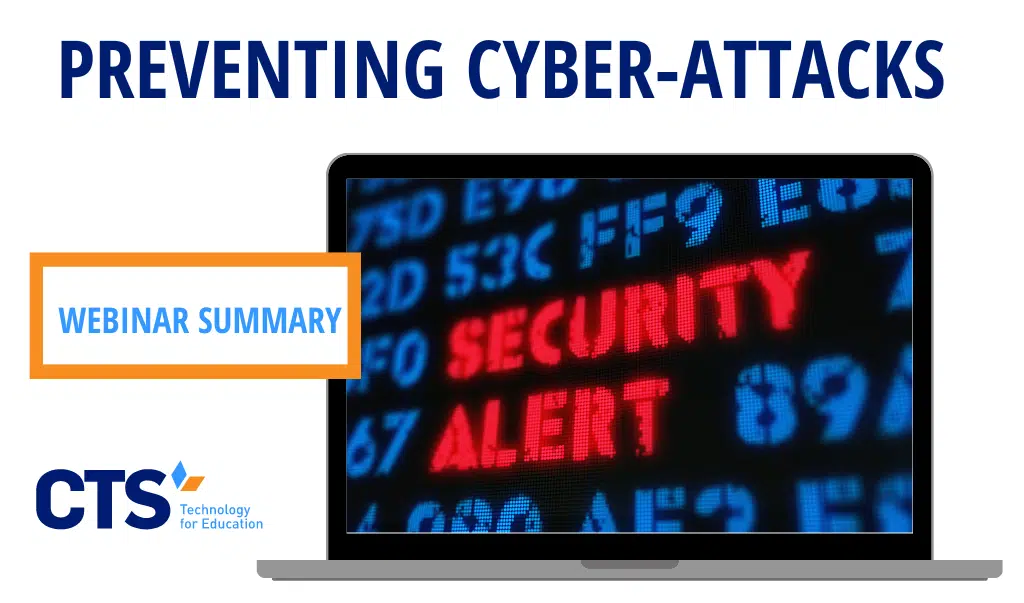Cybersecurity is the practice of protecting computers, servers, mobile devices, networks, and data from digital attacks. Cybersecurity is important because as our reliance on technology increases, so do the number and severity of cyber threats. These threats can range from identity theft and financial fraud to the disruption of critical business operations. Effective cybersecurity helps to ensure the confidentiality, integrity, and availability of information and systems and can help prevent the loss of sensitive information and financial losses. Our recent cybersecurity webinar [video recording] covered this topic for educational institutions.
Ransomware is a particularly heinous type of malware that encrypts a victim’s files and demands a ransom payment in order to restore access to the files. Ransomware attacks are becoming increasingly common, and they can have a significant impact on organizations of all sizes. Schools and small organizations are particularly vulnerable to ransomware attacks because they often have limited resources and lack the expertise to properly protect their networks and data. As a result, they may not have the necessary security measures in place to detect and prevent ransomware attacks.
When ransomware attacks happen on schools and small organizations, it causes a disruption of normal operations and can lead to the loss of important and sensitive information such as student records. The attackers often demand payment in cryptocurrency, which can be difficult for small organizations to acquire. Even if the ransom is paid, there is no guarantee that the attacker will restore access to the encrypted files.
Ransomware and malware attacks can have severe consequences, including financial losses, data loss, and reputational damage. It is difficult to estimate the exact percentage of organizations that never recover from a cyber-attack or ransomware, as the statistics can vary depending on the source and the type of attack. However, it is widely acknowledged that the recovery rate for an organization that is not properly prepared for a security incident is very low.
Small school districts frequently report six-figure losses as the result of a cyberattack. For larger districts, the total losses can be in the millions. For this reason, schools have seen a 300% increase in cybersecurity insurance premiums. Additionally, many insurance underwriters will refuse to provide coverage for organizations that can not prove that they adhere to some of the most basic cybersecurity best practices.
Cyber-attacks have increased significantly over the past decade, driven by a variety of factors such as the increasing use of technology, the growing sophistication of attackers, and the emergence of new types of threats. One factor that has contributed to the increase in cyber-attacks is the growing use of remote work. With the COVID-19 pandemic, many organizations have had to rapidly shift to remote work, which has created new vulnerabilities and attack surfaces. Remote workers often use personal devices and networks that may not be as secure as those provided by their employer, and they may be less familiar with cybersecurity best practices. As a result, attackers have been able to capitalize on these vulnerabilities to launch successful attacks.
How can an organization be better prepared for attacks and prevent security incidents?
Charter Technology Solutions has identified 9 key steps to fighting cyber security, which we refer to as the 9 Pillars of K-12 Cybersecurity:
- Awareness Training: This includes learning how to identify and recognize cyber-attacks, how to respond to attacks, and how to stay proactive to attacks.
- Identity Management: One of the main focuses here is determining who in the organization should have access to what. For example, you might determine it makes the most sense for only the Principal and head finance officer to have access to bank logins. You may wish to implement measures such as multi-factor authentication, which requires more than one password to access a system.
- Endpoint Protection: including antivirus measures, behavior analysis, and cloud protection.
- Compliance: Cyber Security is setting company-wide policies, procedures, and compliance regulations for handling cybersecurity and cyber-attacks within the organization.
- Email Protection: Organizations must push to make sure emails are secured from attackers.
- In the event of an attack or a crash, it is paramount that effective back-ups are in place. You should discuss within your organization and with your IT provider the advantages and disadvantages of physical versus cloud backups.
- Vulnerability Scans: It is important to know how at risk your organization is.
- Anti-Malware: Creating antivirus software, accurate logging, and malware scanning make up our 8th pillar – Edge Security/Firewalls.
- Network Security: It is important your network is protected just as securely as the individual endpoints.
Recap: Cybersecurity is important. One incident can cause thousands or millions of dollars worth of losses to a person or organization. Cyber Security as a risk management tool is critical in any organization that wishes to balance both efficiency and protection. CTS can provide the options you need!




